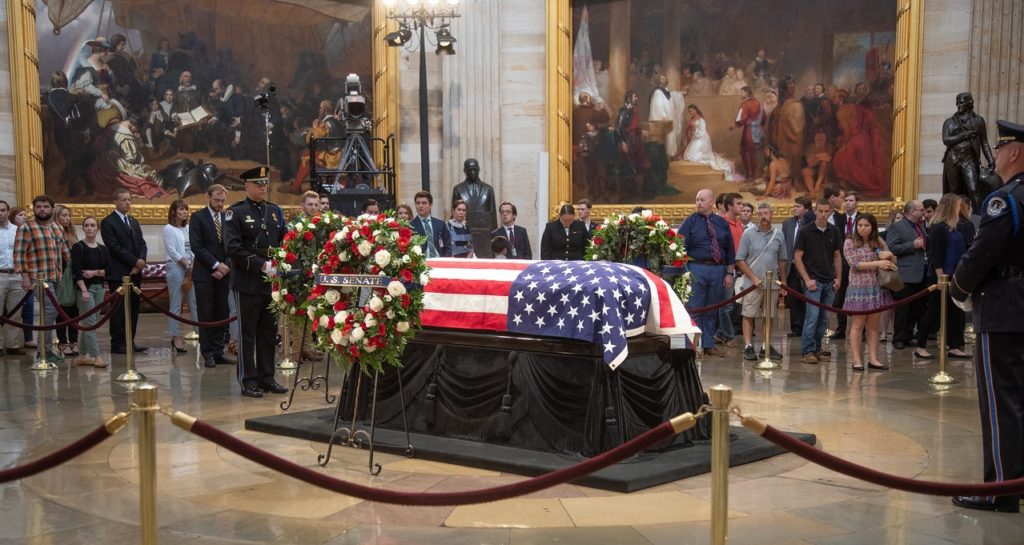John McCain: The Long Goodbye
By • September 3, 2018 0 590

Quietly, on a sunny, hot Sunday afternoon, in a private, no-press ceremony, John McCain, in the climax to days of restless, emotional, private and public mourning, was laid to rest, fulfilling one of his last wishes.
“I want to watch the hawks hunt from the sycamore, and then take my leave bound for a place near my old friend Chuck Larson, in the cemetery on the Severn, where it began,” he had written.
McCain — two-time presidential candidate, U.S. senator, U.S. representative, Navy captain, for years of pain and torture a prisoner of war in North Vietnam, fighter pilot, husband and father, maverick and hero, youthful, boisterous, handsome plebe — ended one last, eventful journey, which began with his death on Aug. 25 in Sedona, Arizona.
There were times during the last five days of mourning that McCain’s life, his bearing and presence seemed most real to us, even in death, as the starkly familiar long black hearse, the coffin covered in the colors and flag of country seared themselves in the hearts and minds of Americans across the nation.
Along the way — in the lyings in state, in the rotundas of state and national shrines, along the side of streets and roads and in the always flickering imagery of smart phones, computers and television screens — Americans acquired and collected memories of the kind that would recur late and later in the day, some days and probably months after.
They would be the memories of the widow in elegant black, her tightly bound hair touching the coffin, tensely strong in churches, rotundas, along the Vietnam Memorial wall to lay a wreath, accepting the condolences as well as the grief of others. You remember the aged mother who outlived her son, and you remembered the children, including the naval officer, the army sergeant. You remembered the placards, the casket carried to the beat of those sharp, short steps.
Along the way, with each passing day, there appeared the real presence of the casket, but also the information we carried around with us from living through the life of John McCain in terms of the daily news, the politics, the debates, the trip of forgiveness to Vietnam, the often spontaneous acts of generosity. Alongside those memories of the five days of official mourning, there emerged, day by day, a cohesive picture of McCain, an idea of him that certainly included the maverick, and the hands-across-the-aisle image, but more than that, the forging of friendships as a tool of action, a trumpet call to respond to the best political urges in our national makeup.
What seemed to emerge, through the solemn, circular walks around the casket in the Capitol Rotunda, but especially at the formal but also informal funeral surrounded by the soaring arches and majesty of the National Cathedral on Saturday last, was the idea of McCain, last man standing against the devolution of politics into warfare without rules of civility and decency, where division and appeals to division increasingly dominate.
It wasn’t just what was spoken at the cathedral, where even irreverent laughter and applause, sometimes heartfelt, sometimes, let it be said, partisan, could be heard. It was the place itself and the people in it, it seemed at times like some watershed moment, a kind of solemn Rubicon, where the waters were receding.
Looking at the seas of faces and mortal bodies wrapped in formality is always an imposing, emotional and even chastening experience. Here were some parts of the heart and soul of American history and governance, past presidents, family members, people who wield and once wielded power of the kind that changed the world. Here were journalists of the elder statesmen (and stateswomen) sort, some frail, some chipper as a tweet, a gathering of the rich and not-quite-so-rich, a gathering of the memorable, who had attended other funerals here. Who recalls Ben Bradlee tapping Katharine Graham’s coffin, or the sea of Sunday-go-to-meeting hats for Dorothy Height’s passing celebration or a lonely Mikhail Gorbachev sitting friendless at Ronald Reagan’s funeral?
The funeral for John McCain often seemed to turn into the funereal of a phase in American history. It was elegiac, a kind of Iliad-and-Odyssey tale of a hero for whom there would be no replacement. Yet, then again, it was not. During the days of mourning, McCain, the good senator and good friend, had become the hero as conciliator, the Hector of bipartisanship, the heckler against the vulgarity and bully-boy tone of present-day politics.
This funeral, planned fully and in great detail by McCain himself, no doubt with friends and family, saw the inspiring spectacle of eulogies delivered by former U.S. presidents — George W. Bush (opponent in the Republican primaries of 2000) and Barack Obama (opponent in the general election of 2008), who thwarted his longing to become president. The presence and participation of these two presidents was practically an ode to embracing bipartisanship, as opposed to a eulogy for it, as well as a kind of affront to the absence of President Donald Trump.
The two presidential eulogists did him proud. Bush: “I can hear John whispering behind me, ‘We can do better, we can do better'” and “I was given one of the great gifts a man could have, the friendship of John McCain.” Obama: “Who else could get the two of us together so that we could say nice things about him?”
Clearly, the most notable absence was the president whom McCain had pointedly not invited, although daughter Ivanka and her husband Jared were in attendance. Early in the 2016 campaign, Trump refused to call McCain a hero because, as Trump said, “I don’t like people who get captured.” It was, no question, a slur not easily forgiven or forgotten and deeply soured the relationship of the two men.
While Bush, Obama and others, including Bill Clinton and Hillary Clinton and venerable former Secretary of State Henry Kissinger, all made allusions to the cruel, mean-spirited political culture which Trump and his constant use of Twitter and rallies have helped to embolden, it was McCain’s daughter Meghan who made her feelings known with eloquence, even raw anger and with no-mistaking the object of the anger. Her face set with determination, she used her words like a dagger. Alluding to the president’s campaign slogan, she said in sharp mocking tones: “The America of John McCain has no need to be made great again, because America already was great.” The remark saw a burst of applause in the filled cathedral.
At the end, an ensemble played “Danny Boy,” sung by star soprano Renée Fleming, touching everyone’s heart, most especially that of the brokenhearted widow Cindy.
During the week, Trump himself was often muted and at other times, awkwardly pensive and small-minded, when he ordered the flag at half-mast returned to full then rescinded that order later. He stayed quiet about McCain for the most part, but did erupt in sporadic bursts of tweets about the intelligence community, fake news and so on.
After the ceremony, he tweeted once: “Make America great again.”
Then again, the coffin, the hearse, left the cathedral for Gawler’s Funeral Home up Wisconsin Avenue. And then again, on Sunday, Sept. 2, the coffin, the hearse, along Route 50, to the burial in Annapolis by the Severn.
Home was the sailor.

